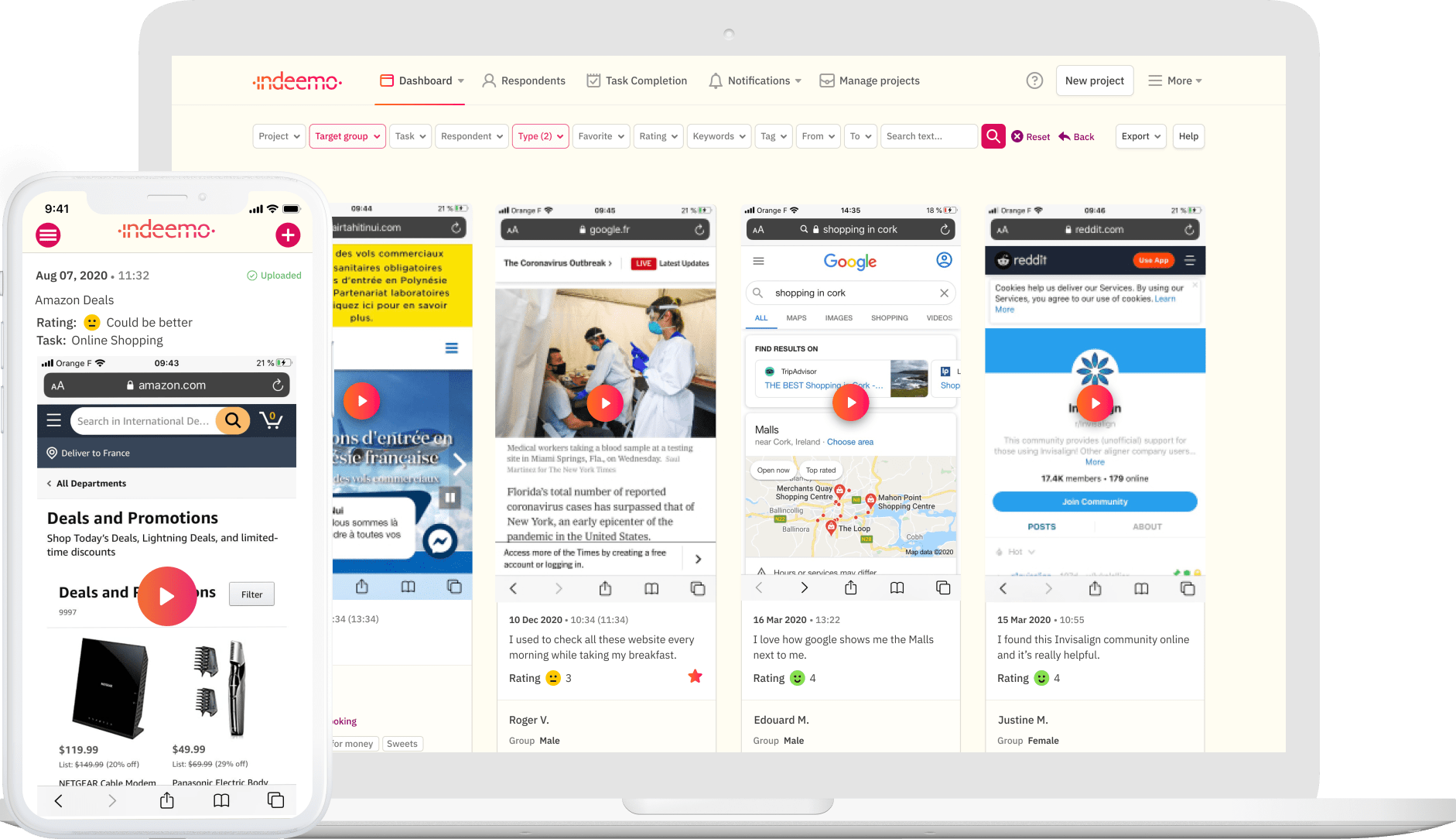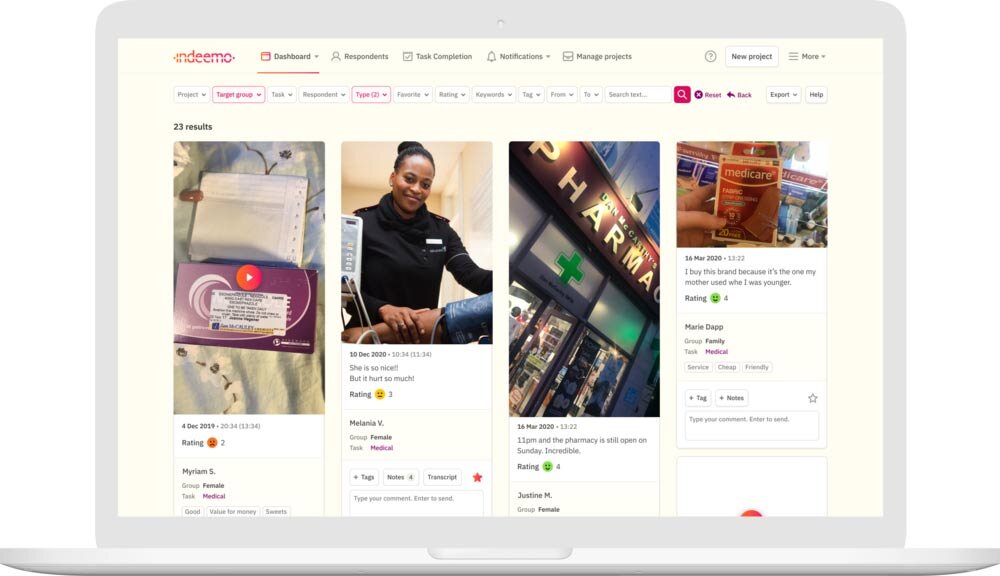Understanding triggers, influences and barriers on your target HCPs is the foundation on which to build an impactful Healthcare Marketing Strategy. This post explains how an healthcare advertising and communications agency used mobile ethnography to conduct remote concept testing with healthcare practitioners.
Align your concept testing with HCPs’ busy schedules using mobile ethnography
In order to become more agile, reduce timelines and capture richer, more in-the-moment feedback from HCPs, pharmaceutical brands need to leverage the power of mobile ethnography to better connect with these busy professionals.
With little time for focus groups or synchronous in-depth interviews and given the challenge of getting Healthcare Professionals, Key Opinion Leaders (KOLs) or Medical specialists into a central location, advertising agencies and pharmaceutical brands and now transitioning to digital solutions that allows them to align their research with the crazy schedules of their target audience.
Using Mobile Ethnography to privately connect with this hard to reach segment is one increasingly preferred research methodology for concept testing of advertising and communications creative.
In particular, giving HCPs the added flexibility to asynchronously complete tasks at a time that works best for them ensures that completion rates are increased and consequently both timelines and research costs can be drastically reduced.
Recruiting for healthcare communication concept testing projects
A typical methodology to get in context, in-the-moment adcept and concept feedback from healthcare and medical professionals using mobile would typically start by consulting a specialist healthcare qualitative research recruiter to source your target respondents. The Qualitative Research recruiter would collaborate with you to prepare a screener and is then tasked with sourcing respondents matching the brief.
Medical or healthcare recruits are typically expensive and time consuming given the low incidence rates and the difficulty of reaching time pressed healthcare specialists. Consequently, expect to pay both thee recruiter and the HCPs several hundred dollars each in order to source and get time with them.
In fact, it’s increasingly being reported to us that HCPs are not in these studies for the money. They are much more likely to be motivated by the purpose of the study and the impact it will likely have. Make sure to inform your recruiter about the background and purpose of the campaign. If you can connect with the HCP on this level, recruitment and engagement will be higher.
Also, expect that respondents will be recruited in drips, sometimes one by one and to cater for this reality, we recommend sequential tasking.
The benefits of sequential tasks for healthcare advertising concept testing
HCPs and medical experts are notoriously difficult to engage using synchronous online qualitative research methodologies such as online focus groups or virtual in-depth interviews.
Furthermore, engaging them face to face like this is more likely to interrupt their schedule than align with it.
As a result, we recommend that you use Sequential Tasking whenever you are testing advertising / communications creative with healthcare experts.
Think of sequential tasking as the “Russian doll” of tasking: with Sequential tasking, tasks are scripted in a linear, gated sequence. As a result, when your healthcare respondents register, they can only see their first task. Once they complete this task, the next task is revealed and so on.
This has two main benefits for healthcare comms research:
Respondents can complete tasks on their own schedule and can move at their own pace.
As future tasks are hidden from respondents, their responses to the early tasks are not biased them being able to see the later tasks.
It is also possible to hide previous tasks so HCPs are not able to refer back to the first concepts that were presented to them. This is especially powerful when it comes to testing recall of advertising creative.
We usually recommend you start with an intro selfie task and ask the respond 3-4 intro questions e.g. get them to introduce themselves and possibly answer 1 or 2 screening questions that can be later clipped and used in your debrief.
These voice of customer videos can supercharge your presentations to your client.
Tasking strategy tips for healthcare advertising / comms testing
When it comes to testing various healthcare or pharmaceutical advertising or communications stimuli – be they images, animatics / adcepts, or 1 page product overviews we recommend that you embed the stimuli in your task list so that respondents can view these stimuli at a time that suits them using their smartphones. This is a really low friction way that aligns your tasks with the reality of the respondents daily routines.
By embedding multimedia concepts into sequential tasks, designed specifically to ensure only one stimulus is seen at a time, respondents can view stimuli in isolation and respond in the moment (using text or video feedback) without any outside influences or distractions.
By viewing one concept at a time, you are capturing the initial gut reaction of the respondent to each one without being influenced by each other. Respondents cannot move onto the next task until they complete the current task which ensures that they cannot skip ahead.
Furthermore, if required, stimuli can be hidden from view enabling you to test how well respondents recall the concept they just viewed.
Mobile Screen Recording
In particular, Mobile Screen Recording can be particularly powerful when you want to research how respondents react to various content or stimuli in the moment.
With mobile screen recording, you can get respondents to record themselves browsing and reading the content and everything the do on screen including their voice is recorded as they respond to each stimulus or concept.
After all tasks are completed, a final reflection task can be set to review all concepts collectively and see if opinions have changed after seeing and completing all tasks.
Using mobile concept testing as a pre-task
The majority of our clients use Mobile Ethnography as a standalone research methodology for concept and adcept testing.
However, some clients might be unwilling to take the leap entirely away from online focus groups or IDIs.
As a result, we recommend that when pitching clients, you propose an approach where you get 30-40% of the respondents to do a follow up IDI or focus group. This gives clients the reassurance that the approach is not a significant deviation from the traditional “tried and tested” approaches they are used to.
By getting respondents to engage and provide feedback on concepts and adcepts using the mobile ethnography app ahead of your in-person meetings, you get to know the respondents before you get to meet them virtually. You can also screen share the Indeemo dashboard to get them to remember what they said about each concept which can trigger a powerful deep dive dialogue.
Bring your concept testing to life on our Insights Dashboard
Using sequential, user-driven tasking, which allows Respondents to complete tasks in their familiar environment while working around their schedules, gives you genuine, gut reaction responses without outside influences.
All of their responses are seamlessly collated on a Pinterest Style dashboard where you can filter, moderate and analyse the media rich feedback on your creative.
You can also use social networking style probes (delivered via push notifications) to engage respondents over mobile. This enables you to hit the ground running if you choose to meet the respondents in person and you can quickly change the dynamic of the in-person session from being about exploration to being about explanation.
Again this can cut down the amount of time you need from each respondent making it easier to convince them to take part.
Schedule a quick strategy call
Indeemo has been used successfully to test concepts, products and adverts ranging from wearable medical devices to communications testing aimed at healthcare professionals and medical consultants.
Our customers consistently remark on the richness of the feedback that can be captured using a remote, digital qualitative research approach compared to testing feedback face to face in a lab or central location.
We’ve supported hundreds of projects in healthcare comms testing and would be delighted to share some strategies with you.






